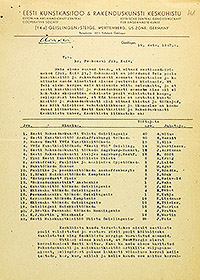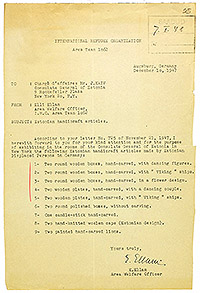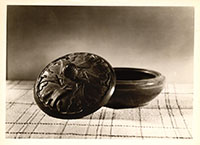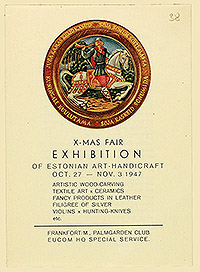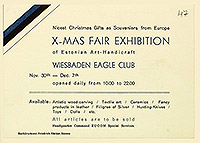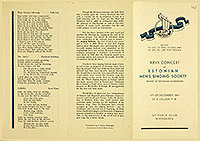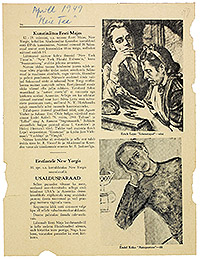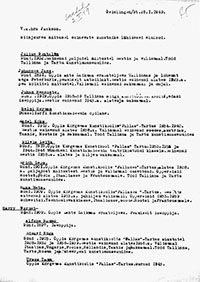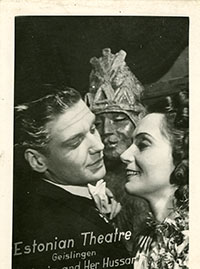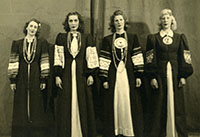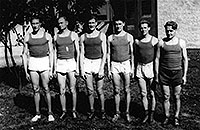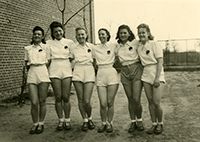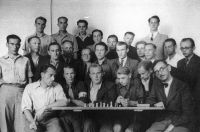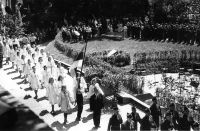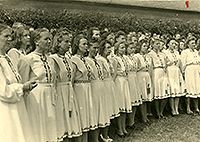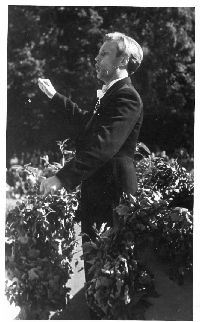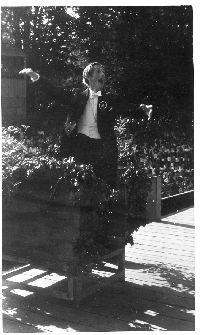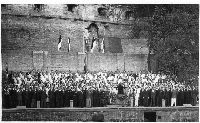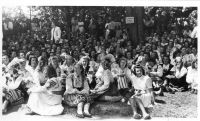Culture and sport activities
Shortly after the establishment of DP camps in the summer of 1945 until late autumn, camps actively organised singing and dancing groups, schools opened and created drama and handicraft circles, as well as boy and girl scouts groups. Regular participation in sports and hobby groups offered a variety to monotonous everyday life from the inhabitants of the camp.
The Germany's Estonians Song Festival, one of the major joint activities, was held in August 1947 in Augsburg and was attended by more than 5000 Estonians. They performed at the festival in folk costumes, which they had made while living in Germany. The Song Festival became a reality thanks to the active choirs that started in the summer of 1945 – by the next year there were already over 60 choirs in the Estonian community in Germany, and in the summer of 1945, the Estonian Choir Centre was founded in Geislingen. In addition, song days began in the summer of 1946, which contributed to the success of keeping the music schools going. In May 1945, another organisation was founded, the Estonian Artists in Lübeck, which included renowned pianists as well as violinists, sopranos and tenors. Of the better known Estonian musicians in Germany was Hubert Aumere, who performed violin concerts in the camps and worked as a concert master in the Munich National Theatre Orchestra.
The majority of professional Estonian actors were located in the northern part of Germany in Schleswig-Holstein; dancers and smaller acting companies, as well as soloists and conductors could be found more throughout the southern part of Germany. The largest theatre company operated in Geislingen, which was founded as the Geislingen Estonian National Theatre, with 27 people on 1 November 1945. Soon the theatre company was given use of the city's best theatre, the 700-seat Jahnhalle. The first performance was held on 1 December, entitled "Estonia's Eve", where both vocal and instrumental soloists performed with speeches and dances. The Geislingen musical theatre productions worth mentioning are the operetta "Mariza", as well as "Viktoria and her Hussar", which was performed 30 times and where Estonians and Germans praised the performance of the former "Vanemuine" actress Helmi Aren. The theatre also had an orchestra, which in the autumn of 1946 had 29 members, most of which were amateurs. Orchestra conductors were Peeter Paul Lüdig and Roman Toi. The theatre choir consisted of up to 35 singers. The Geislingen theatre gave 157 performances to 90,000 spectators from December 1945 to June 1947.
The Estonian National Theatre in the British zone in Schwarzenbek and the Puppet Theatre in Augsburg gave 250 performances over two years to close to 68,000 spectators. In addition, there were some of the members of the well known Memmingen Estonian Theatre and other smaller theatre companies in a couple dozen of the camps.
A surprisingly large number of publications (over 400 titles) were published in the camps in Germany, in particular textbooks, which were needed in Estonian schools. Literary works were given out as classics and contemporary works including many reprints of children's books as well as new publications. Of the well known authors in Germany there were Henrik Visnapuu, Pedro Krusten, and Aleksis Rannit, who all later went to the US. The first post-war fiction book released in Germany was Aleksis Rannit's collection of verses "Käesurve", after which followed Henrik Visnapuu's collection of poetry in 1946 "Tuuline Teekond", of which 5000 copies were published, a rare phenomenon in exile, and Pedro Krusten's novel "Üle parda". The book publishers in Germany were Estonia, Kultuur, Eddy, and the Eestlaste Keskesindus in the US zone. Textbook publishing had an important place in Geislingen's Estonian High School, and published over 40 textbooks that were also sent to other German Estonian schools.
With information shortages in the camps, newsletters and bulletins began to be distributed, with the first issue published on 6 June 1945 called "Aja Kaja" in Uklei camp. Since more than 30 professional Estonian journalists had arrived in Germany, journalism was a lively activity. The first printed newspaper "Eesti Teated", was published on 11 August 1945 in Göttingen, and thanks to Eduard Vallaste's editing, was printed weekly and had a distribution of 6000 copies. On 29 September 1945, the newspaper "Eesti Rada" was published in the US zone, after which the bulletin "Eesti Post" was widely distributed in Geislingen, which was printed in 1946 and became one of the largest newspapers in Germany until it closed in 1953. "Eesti Rada" is published in Germany to this day. In addition to those mentioned, there was a series of bulletins, newspapers, and magazines published in the camps.
In addition to the good level of cultural events, workshops were started in the camps and courses were held for people to acquire the necessary skills in specific disciplines (e.g. electrical engineering), as well as useful everyday life pursuits (for example, photography and handicrafts). There were close to 50 artists representing Estonia in visual arts in Germany, as well as 24 applied artists, in addition to a few renowned painters, graphic artists, sculptors, and architects. Under their leadership, workshops and art and ethnographic exhibits were organised.
Sporting activities were developed similarly to other joint organised events immediately following the establishment of camps. In the US zone, Estonians held the first major sporting competitions already in 1945 from 15–16 August in Augsburg in the United States' Military Stadium. Participants came from several camps; there were competitions for men, women, and boys in the A and B series of track and field, as well as basketball and volleyball. Even more spectacular action was had on 19–20 October at the Baltic Olympiad in Augsburg, where Estonia, Latvia and Lithuania competed in track and field, volleyball, and football. Only a little earlier, in August, the US zone's sports games were organised in Geislingen, where these two large camps competed.
| The representatives of Estonian Art-Handicraft Central Cooperative Society, Mr. Vello Rebane and K. A. Nõmmisto, confirm in a letter addressed to the consul general Mr. Johannes Kaiv their desire to exhibit and market the articles made by the Estonian craftsmen. The letter contains a list of the member organizations of Estonian Art-Handicraft Central Cooperative Society in Germany. ERA.1608.2.950, page 30 (digitized, www.ra.ee/saaga) |
|
| A list of showpieces made by the Estonian craftsmen in Germany for the exhibition of 1947 held in the Consulate General of Estonia in New York. ERA.1608.2.953, page 25 (digitized, www.ra.ee/saaga) |
|
| Examples of the showpieces presented in the same exhibition. ERA.1608.2.953, pages 9 and 11 (digitized, www.ra.ee/saaga) |
|
| An advertisement of Estonian art-handicraft Christmas exhibition (October 27 – November 3, 1947, Frankfort, USA). ERA.1608.2.953, page 38 (digitized, www.ra.ee/saaga) |
|
| An advertisement of Estonian art-handicraft Christmas exhibition (November 30 – December 7, 1947, Wiesbaden, USA). ERA.1608.2.953, page 47 (digitized, www.ra.ee/saaga) |
|
| A program of the 27th concert of Estonian Men's Singing Society. December 4, 1947, Wiesbaden. ERA.1608.2.953, page 48 (digitized, www.ra.ee/saaga) |
|
| An overview of the Estonian DPs art exhibition held in New York and published in the newspaper of "Meie Tee" in April, 1949. The exhibition was arranged by an Estonian organization "Akadeemiline Koondis" lead by Ernst Jaakson. On March 12–19, 1949, 16 Estonian artists living in Germany (including Agathe Veeber, Salome Trei, Endel Kõks etc.) were presented their works in Estonian House in New York. ERA.1608.2.954, page 98 (digitized, www.ra.ee/saaga) |
|
| Short biographies of the Estonian artists performing their works in Estonian House in New York on March 12–19, 1949. Sent on January 25, 1949, by Endel Kõks from Geislingen to Ernst Jaakson who lead the exhibition's arrangement committee. ERA.1608.2.954, pages 75–76 (digitized, www.ra.ee/saaga) |
|
| An advertisement of Estonian Theatre in Geislingen, actress Helmi Aren. VEMU FK.61-38 |
|
| Singers in DP camp in Lübeck, 1947: Maret Pank, Lydia Vohu, Kadi Tanilo, ?. VEMU FK.61-45 |
|
| Volleyball team of DP camp in Amberg in August of 1948: Hans Raag, Voldemar Pähn, ?, Aksel Salumets, Harri Lambur, K. Leosk. VEMU FK.61-42 |
|
| Estonian volleyball team of Schwarzenbek, masters of the British zone: sisters Sammalsoo, Rae, ?, Seepere, Tõsine. The Baltic Days in Lübeck in 1947. VEMU FK.61-58 |
|
| Chess players of DP camp in Amberg before the tournament in September of 1947. VEMU FK.61-47 |
|
| Procession of the song festival in Augsburg on August 10, 1947. VEMU FK.61-91 |
|
| Performers at the song festival in Augsburg on August 10, 1947. VEMU FK.61-53 |
|
| Conductor Udo Kasemets at the song festival in Augsburg on August 10, 1947. VEMU FK.61-84 |
|
| Conductor Roman Toi at the song festival in Augsburg on August 10, 1947. VEMU FK.61-86 |
|
| Joint choir at the song festival in Augsburg on August 10, 1947. VEMU FK.61-87 |
|
| Performers at the song festival in Augsburg on August 10, 1947. VEMU FK.61-88 |
